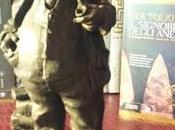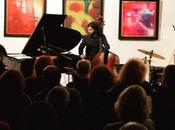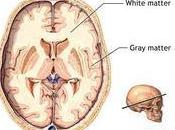 MILANO: i rifugi della Seconda Guerra Mondiale - di ROANNA WEISS per Milano Arte Expo - rubrica MILANO IN QUATTRO PASSI. Bilingue: italiano / inglese – Non dobbiamo sempre andare al museo per vedere l’arte e la storia. C’è sempre qualcosa intorno all’angolo. Sono una nativa di Philadelphia, una città piena di storia, anche se è una storia più giovane di quella d’Europa, ho un Master in Studi dell’Alto Medioevo (giuro che è utilissimo per la vita!) e ho deciso di restare in Europa per essere vicina alla storia dei miei studi. Però ho imparato qualcosa di nuovo vivendo a Milano. Non devo cercare le rovine di una chiesa antica, non devo salire in cima del Duomo e neanche andare al museo per vivere un pezzo di storia. La storia ci circonda ed è una storia che un americano vive un po’ diversamente. >>
MILANO: i rifugi della Seconda Guerra Mondiale - di ROANNA WEISS per Milano Arte Expo - rubrica MILANO IN QUATTRO PASSI. Bilingue: italiano / inglese – Non dobbiamo sempre andare al museo per vedere l’arte e la storia. C’è sempre qualcosa intorno all’angolo. Sono una nativa di Philadelphia, una città piena di storia, anche se è una storia più giovane di quella d’Europa, ho un Master in Studi dell’Alto Medioevo (giuro che è utilissimo per la vita!) e ho deciso di restare in Europa per essere vicina alla storia dei miei studi. Però ho imparato qualcosa di nuovo vivendo a Milano. Non devo cercare le rovine di una chiesa antica, non devo salire in cima del Duomo e neanche andare al museo per vivere un pezzo di storia. La storia ci circonda ed è una storia che un americano vive un po’ diversamente. >>
I segni di guerra più sentiti sulla terra americana sono Pearl Harbor e gli attacchi dell’11 settembre. Questi sono i soli attacchi nella memoria vivente e sono stati in luoghi molto concentrati o nel caso di Pearl Harbor molto lontano dalla maggioranza dei centri abitati. La guerra di indipendenza e la guerra di secessione americana non hanno lasciato gli stessi segni. Abbiamo siti storici, campi di battaglia, delle targhe, ma nient’altro.
Girando per le strade di Milano possiamo vedere dei segni sugli edifici (nell’immagine: Via Castelvetro 1). Questi sono gli avvisi dei rifugi durante i bombardamenti della seconda guerra mondiale. L’idea di un attacco così vicino a casa fa impressione non solo a un americano, ma anche a un giovane italiano che non ha vissuto la guerra.

Foto di Roanna Weiss – via Castelvetro a Milano
Quando l’ho visto e fotografato mi è venuto in mente La Storia di Elsa Morante, i telefilm fatti in Italia negli ultimi anni sulla seconda guerra mondiale e anche gli innumerevoli documentari che mostrano l’Italia del Fascismo e della guerra. Essendo madre ora, vedo, o meglio immagino, le facce delle donne spaventate che correvano verso quella porta con un bambino in braccio o mano nella mano pensando solo di salvarlo più di sé stessa. E immagino che lì su una strada dove passo quasi ogni giorno, giacciono i corpi di chi non ce l’ha fatta a raggiungere il rifugio in tempo.
Ormai per me la storia non è il lontano passato dei miei studi, anche se rimane un periodo molto caro a me e importante per la nostra società. La storia è qualcosa che ho toccato con la mano dopo aver scattato la foto. E’ quella che ha reso la signora anziana che incontro per la strada forte e determinata nello sguardo, perché anche se sembra fragile, lei magari ha salvato delle vite correndo mano nella mano proprio verso quel rifugio.
Quando passate per le strade di Milano, guardate gli edifici. Vedete una “R”, o magari una freccia anche se quasi del tutto lavata via dal tempo. Quel posto lì va ricordato per tutte le persone che hanno corso in terrore verso la salvezza.
-

The closest signs of war on American soil are Pearl Harbor and and the attacks of 11 September. These are the only attacks in living memory and are in very concentrated locations or in the case of Pearl Harbor very far from the majority of the US cities. The American Revolution and the Civil War didn’t leave the same signs. We have historic sites, battlefields, plaques, but nothing else.
Walking around the streets of Milan we can see signs on some buildings (in the image: Via Castelvetro 1). These are the signs of bomb shelters for the Second World War. The idea of an attack so close to home makes a big impression not only on an American, but also on a young Italian who didn’t live through the war. When I saw and photographed this sign, the novel History by Elsa Morante came to mind, as did the TV films made in Italy in recent years about the Second World War and also the numerous documentaries showing Fascist and war-torn Italy. Being a mother now, I see, or rather I imagine, the faces of frightened women running towards that door with a baby in their arms or hand in hand, thinking only of saving their child more than themselves. I imagine that there on a street I pass almost every day lay the bodies of those who didn’t make it to that door in time.
Today history is no longer that faraway past of my studies, even though it remains a period very close to me and important to our society. History is something that I’ve touched with my hand after taking that photo. It is that which made the elderly woman we meet on the street strong and determined in her eyes, because even if she seems so frail, perhaps she saved a life running hand in hand towards that bomb shelter.
When you walk down the streets of Milan, look at the buildings. Do you see an “R”, or maybe an arrow, even if it’s almost completely washed away by time? That place there must be remembered for all the people who ran in terror towards salvation.
Roanna Weiss
Roanna Weiss, scrittrice e traduttrice con una passione per la fotografia, si occupa di arte, cultura e vita da espatriati in Italia. Per informazioni e contatti: www.roannaweiss.com
-
-
MAE Milano Arte Expo [email protected] ringrazia Roanna Weiss per la rubrica MILANO IN QUATTRO PASSI e per l’articolo e le foto I rifugi della Seconda Guerra Mondiale a Milano.

-
-






